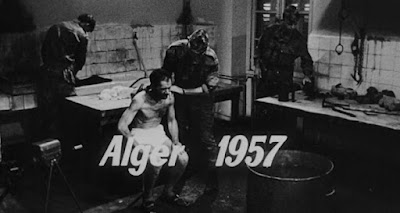Battle of Algiers - the opening sequence, encoding ideological perspectives and exploring the representation of RSAs and ISAs
- The French military is represented as dominant and clearly repressive. The opening shot of the film. The high angled long shot of the tortured Algerian constructs an ideology where he is weak and vulnerable to the military, who are skulking around the room in uniform. We are instantly aligned as a spectator with the vulnerable and older algerian. Even in this long shot, we see the fear and trauma in his face. The tiled walls of the setting connote violence, as they can easily be cleaned, suggesting the awful things which have happened in this room. This opening shot constructs the Algerians as an underdog and the French as a dominant repressive state apparatus.
- In a subsequent shot, a binary opposition is constructed between the powerful European occupying forces and the weak and vulnerable Algerian. The casting of the actor is perfect. His sad and vulnerable face creates a sense of empathy from the spectator. The actor who plays him is non-professional, which heightens the sense of discomfort and awkwardness, which is in turn anchored through the wordlessness of his performance, suggesting he fears being punished by the repressive regime.
- One soldier gently mocks the prisoner, yet is stopped by the commander. Instead of torturing him further, they fetch him a cup of coffee, mentally torturing him by forcing him to question his own morals. The soldier attempts to play a joke on the Algerian, but is stopped by Matthieu in an apparent act of kindness. This bizarre ritual reinforces the idea that the commander is in charge of this situation
- We cut to the raid on the casbah. A militant drum beat is accompanied by an intimidating piano motif and threatening brass. These militaristic tones construct an ideology where the well equipped French army are clearly willing to utilise lethal force to kill a single person
- When we first see Ali, we see him hiding behind a wall with a man, a woman and a child, constructing the Algerian resistance force as the underdog.
- The camera slowly pans across the faces of the four, introducing each one of them in closeup. This helps to align the spectator with the Algerians, and in particular Ali, a hegemonically attractive and serious looking young man. Yet it also constructs a complex and alarming ideology where Ali has clearly had to debase himself in order to survive the French occupation.

